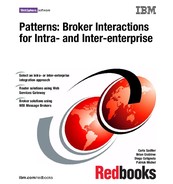92 Broker Interactions for Intra- and Inter-enterprise
5.1 Node types
A Runtime pattern consists of several nodes representing specific functions.
Most Runtime patterns consist of a core set of common nodes, with the addition
of one or more nodes unique to that pattern. To understand the Runtime pattern,
you will need to review the following node definitions.
Application Server/Services
The Application Server/Services node provides the infrastructure for application
logic and can be part of a Web application server. It is capable of running both
presentation and business logic but generally does not serve HTTP requests.
When used with a Web server redirector, the Application Server/Services node
can run both presentation and business logic. In other situations, it can be used
for business logic only. The Application Server/Services node supports hosting of
Web services applications.
Applications may also rely on services provided by their hosting server to interact
with other applications. Examples of services provided by the Application
Server/Services node include:
? A TCP/IP pipe established using the hosting operating system
? A servlet or EJB invoked by WebSphere Application Server
? The JMS or J2EE Connector APIs provided by WebSphere
Broker
The Broker node allows distribution and decomposition/recomposition of
messages so a single interaction from a source component can be switched,
split, and joined to multiple target components concurrently. It separates the
application logic from the distribution logic based on broker rules. The broker
also manages the decomposition/recomposition of the interaction using these
rules.
Exposed Broker
The Exposed Broker node is an extension of the Broker node. It exposes
external processes to the broker functions within the node. A variation of this
would be to use the Exposed Broker to expose internal processes to external
partners.
Router
The Router node is a variation of the Broker node. It allows a single interaction
from a source component to be switched and adapted to only one of multiple
target components. It separates the application logic from the distribution logic
based on router rules.
Chapter 5. Runtime patterns and product mappings 93
Exposed Router
The Exposed Router node is an extension of the Router node. It exposes
external processes to the Router functions in the node. A variation of this would
be to use the Exposed Router node to expose internal processes to external
partners.
Rules Repository
The Rules Repository node contains the rules generally used to control the mode
of operation of an interaction, depending on external factors. Examples of such
rules are:
? Business data mapping rules (for adapter connectors)
? Autonomic rules (such as priority in a shared environment)
? Security rules
? Capacity and availability rules
The rules directory may or may not exist. If it does exist, it could still be left off the
Runtime pattern, for example, when analysis determines that interaction rules
are not an important part of the solution.
Domain QoS providers
The integration pattern for a domain is composed of a topology pattern and
domain QoS providers. Intra-enterprise integration and inter-enterprise
integration are both examples of domains. This combination of topology pattern
and QoS providers is used to describe observed patterns in the domain:
Integration pattern = topology pattern + QoS providers
The QoS capabilities framework can be used to address the particular QoS
concerns for the domain:
? Autonomic
? Availability
? Federation
? Performance
? Security
? Standards compliance
? Transactionality
The domain QoS providers may or may not exist. If they do exist, they can still be
left off the Runtime pattern, for example, when analysis determines that domain
QoS providers are not an important part of the solution.
94 Broker Interactions for Intra- and Inter-enterprise
Protocol firewall node
A firewall is a hardware/software system that manages the flow of information
between the Internet and an organization's private network. Firewalls can
prevent unauthorized Internet users from accessing private networks connected
to the Internet, especially intranets, and can block some virus attacks (as long as
those viruses are coming from the Internet). A firewall can separate two or more
parts of a local network to control data exchange between departments.
Components of firewalls include filters or screens, each of which controls
transmission of certain classes of traffic. Firewalls provide the first line of defense
for protecting private information, but comprehensive security systems combine
firewalls with encryption and other complementary services, such as content
filtering and intrusion detection.
Firewalls control access from a less trusted network to a more trusted network.
Traditional implementations of firewall services include:
? Screening routers (the protocol firewall)
? Application gateways (the domain firewall)
A pair of firewall nodes provides increasing levels of protection at the expense of
increasing computing resource requirements. The protocol firewall is typically
implemented as an IP router.
Domain firewall node
The domain firewall is typically implemented as a dedicated server node.
A domain firewall is usually used to separate a secure zone, such as the internal
network, from a demilitarized zone. This provides added security protection from
the un-secure zone, such as the Internet.
Partner infrastructure
Partner infrastructure includes the partner's installed applications, data,
computing, and network infrastructure. Partner infrastructure has unspecified
internal characteristics; only the means with which to interact with it are specified.
Inter-enterprise network infrastructure
Inter-enterprise network infrastructure includes the network infrastructure
allowing connectivity between enterprises. Inter-enterprise network infrastructure
has unspecified internal characteristics; only the means with which to interact
with it are specified.
..................Content has been hidden....................
You can't read the all page of ebook, please click here login for view all page.
